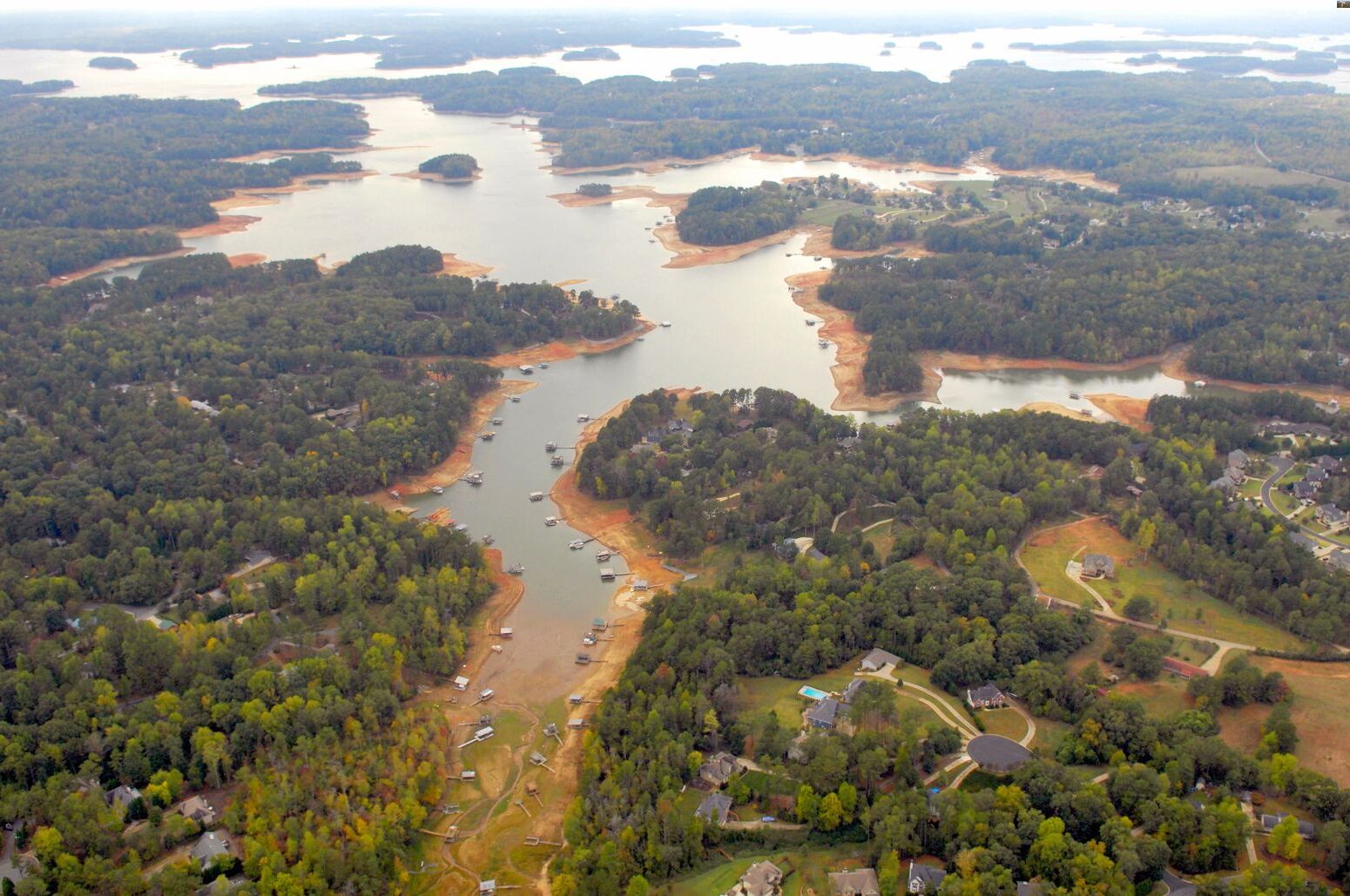
Why is Lake Lanier so captivating? Nestled in North Georgia, Lake Lanier is a man-made marvel with a rich history and diverse recreational activities. Created in the 1950s by the construction of Buford Dam on the Chattahoochee River, this 59-square-mile reservoir serves multiple purposes, from flood control to hydroelectric power. Named after poet Sidney Lanier, the lake boasts 690 miles of shoreline, making it a hotspot for fishing, boating, and even legends of mysterious creatures. Beyond its scenic beauty, Lake Lanier has a storied past, including the submerged town of Oscarville and its role in the 1996 Summer Olympics. Whether you're an angler, history buff, or thrill-seeker, Lake Lanier offers something for everyone.
Key Takeaways:
- Lake Lanier, located in North Georgia, covers 59 square miles and has a shoreline of 690 miles. It was created in the 1950s for flood control, hydroelectric power, and water supply to Atlanta.
- With over 38 billion gallons of water, Lake Lanier is a significant reservoir fed by the Chattahoochee River. It offers diverse recreational activities, hosts annual events, and has a rich historical and cultural impact on local communities.
Location and Size
Lake Lanier is a gem in North Georgia, just a short drive from Atlanta. Its vast expanse and scenic beauty make it a favorite spot for many.
- Location and Size: Lake Lanier covers 59 square miles and boasts a shoreline stretching about 690 miles, making it one of Georgia's largest lakes.
Creation and Purpose
The lake's origins are tied to a significant engineering project aimed at benefiting the region in multiple ways.
- Creation and Purpose: Constructed in the 1950s with the Buford Dam on the Chattahoochee River, Lake Lanier was designed to control floods, generate hydroelectric power, and supply water to Atlanta.
Historical Significance
Lake Lanier holds a rich history, from its naming to the communities it impacted.
-
Named After Sidney Lanier: The lake honors Sidney Clopton Lanier, a 19th-century American poet. Congress authorized its construction in 1946, and it became operational in 1957.
-
Managed by the U.S. Army Corps of Engineers: The U.S. Army Corps of Engineers oversees Lake Lanier as part of a larger dam system within the Apalachicola, Chattahoochee, and Flint basin.
Water Source and Capacity
Understanding the lake's water dynamics is crucial for appreciating its role in the region.
-
Water Source: The Chattahoochee River, along with smaller tributaries, feeds Lake Lanier, providing essential water to Atlanta.
-
Capacity: With over 38 billion gallons of water, Lake Lanier is a significant reservoir.
Depth and Islands
The lake's physical features add to its allure and recreational potential.
-
Depth: The deepest point at Buford Dam reaches about 160 feet, with a full pool elevation of 1071 feet above sea level.
-
Islands: Numerous islands, like Bald Ridge Island and Three Sisters Island, dot the lake, offering tourist attractions and recreational facilities.
Fishing and Legends
Lake Lanier is a paradise for anglers and a source of intriguing local legends.
-
Fishing Paradise: Known for its diverse fish species, including bass and catfish, the lake hosts several fishing tournaments annually.
-
The Lake Lanier Monster: Legends speak of a mysterious creature in the lake, described variably as a sea serpent or giant fish.
Recreational Activities
The lake offers a plethora of activities for visitors of all ages.
-
LanierWorld Water Park: This popular water park within the lake features slides, wave pools, and lazy rivers.
-
Olympic History: Lake Lanier hosted the rowing and canoeing events during the 1996 Summer Olympics, and the course is still used for competitions.
Environmental and Safety Concerns
The lake's management involves addressing environmental issues and ensuring visitor safety.
-
Drought Controversy: Severe droughts have affected water levels, sparking debates on water usage and conservation.
-
Boat Rental Capital: Often called the "Boat Rental Capital of the World," visitors can rent various watercraft to explore the lake.
Cultural Impact
The creation of Lake Lanier had profound effects on local communities and their heritage.
-
Movie Filming Location: The lake's picturesque views have made it a backdrop for films like "The Hunger Games: Catching Fire."
-
Annual Events: Fireworks displays, boat parades, and music concerts are among the many events held at the lake.
-
History of Oscarville: The lake's creation flooded historic sites, including the town of Oscarville, a predominantly African-American community.
-
Superstitions and Hauntings: Some believe the spirits of Oscarville linger, adding to the lake's mysterious reputation.
Safety and Economic Impact
Despite its beauty, Lake Lanier has a reputation for being dangerous, but it also significantly boosts the local economy.
-
Fatalities and Accidents: Over 200 fatalities have occurred since 1994, from boat collisions to drownings.
-
Construction Timeline: Building the lake began in 1950 and took six years, with the lake reaching full pool elevation in 1958.
-
Relocation of Communities: The lake's creation required moving 250 families, 20 cemeteries, 15 businesses, and 6 churches.
-
Economic Impact: The lake supports tourism, recreation, and water sports, generating substantial revenue.
Recreational Opportunities
Lake Lanier offers a wide range of activities for outdoor enthusiasts.
-
Recreational Activities: Besides fishing and boating, visitors can enjoy swimming, kayaking, canoeing, and water skiing.
-
Environmental Concerns: Balancing water supply, recreation, and conservation is crucial for sustainable management.
Historical and Cultural Sites
The lake's creation submerged several sites of historical and cultural importance.
-
Historic Sites: The flooding of towns like Oscarville holds significant historical value, remembered through commemorative events.
-
Native American History: Before the lake, the area was home to Native American families displaced by settlers in the 1800s.
Community and Safety Measures
Efforts are ongoing to ensure the safety and well-being of visitors and local communities.
-
Community Impact: While the lake brought economic benefits, it also resulted in the loss of homes and cultural heritage.
-
Safety Measures: Authorities have implemented boating safety education, increased patrols, and improved signage to reduce accidents.
Visitor Statistics and Water Quality
Lake Lanier's popularity and water quality are closely monitored to ensure a safe and enjoyable experience.
-
Visitor Statistics: In 2019, the lake had 12.1 million visitors, making it one of the most visited Corps projects in the U.S.
-
Water Quality: The lake's water is treated and distributed to Atlanta, providing clean drinking water to millions.
Hydroelectric Power and Navigation
The lake plays a vital role in energy production and navigation.
-
Hydroelectric Power: The Buford Dam generates renewable energy, converting water's kinetic energy into electricity.
-
Navigation: The lake's depth and width make it suitable for various watercraft, from small boats to large commercial vessels.
Flood Control and Recreation
Lake Lanier's primary purposes include flood control and providing recreational opportunities.
-
Flood Control: The Buford Dam helps regulate the Chattahoochee River's flow, preventing downstream flooding.
-
Recreation and Tourism: The lake attracts visitors worldwide, offering activities like swimming, fishing, and boating.
-
Legacy and Cultural Significance: Lake Lanier's creation has shaped local communities, with its legacy felt through commemorative events and exhibits.
The Legacy of Lake Lanier
Lake Lanier stands as a testament to human ingenuity and nature's beauty. Created in the 1950s with the Buford Dam, it now spans 59 square miles and boasts 690 miles of shoreline. This man-made marvel provides clean drinking water to millions in Atlanta, generates hydroelectric power, and offers endless recreational activities. From fishing and boating to hosting Olympic events, Lake Lanier attracts millions of visitors annually.
Yet, its history is complex. The flooding of Oscarville and other communities, along with the displacement of Native American tribes, adds layers of cultural significance and controversy. Despite challenges like droughts and safety concerns, Lake Lanier remains a vital resource and a beloved destination. Its legacy continues to shape the region, blending historical depth with modern-day enjoyment. Whether you're fishing, boating, or simply soaking in the scenery, Lake Lanier offers something for everyone.
Frequently Asked Questions
Was this page helpful?
Our commitment to delivering trustworthy and engaging content is at the heart of what we do. Each fact on our site is contributed by real users like you, bringing a wealth of diverse insights and information. To ensure the highest standards of accuracy and reliability, our dedicated editors meticulously review each submission. This process guarantees that the facts we share are not only fascinating but also credible. Trust in our commitment to quality and authenticity as you explore and learn with us.


